Disclaimer: Canola Watch content is research-based, but broadcast canola seeding is not a well-researched practice. Tips in this article are based on experience. Canola growers may consider broadcast seeding when excess moisture delays timely seeding using “normal” well-researched practices.
Best results for rapid and uniform canola emergence tend to come when seed is placed 1/2” to 1” deep into warm, moist soil and packed lightly. However, broadcast seeding can work in a pinch when the calendar ticks toward June and fields are still too moist for a farm’s regular seeding tool.
Tips
Timing
Broadcast seeding in late May could have higher yield potential than waiting two weeks for ground to support the drill. Manitoba crop insurance data show that canola seeded in Manitoba the first week of June yields 90 per cent of average. Another interpretation is that field conditions still have time to improve and allow for “regular” seeding and decent yield potential. If by late May or early June broadcast seeding still appears to be the best solution for wet fields, the warmer soils should result in rapid germination and establishment of the seedlings.
Seed rate and seed survival expectations
Seed germination and seedling survival could be lower for broadcast canola, but not necessarily. In the Canola Council’s Ultimate Canola Challenge site in Manitoba in 2013, one team broadcast onto moist, warm soil, and had exceptional seed survival. Manitoba experience with warm, moist soils show very good seed survival as long as fields can be harrowed after seeding to improve seed to soil contact.
It may be worthwhile to set a broad range of expectations. At 10 seeds per square foot, low emergence of 20 per cent will result in two plants per square foot. Not great, but not a disaster – as long as the stand is relatively uniform across the field. (A study on canola reseeding showed that a uniform canola stand with two plants per square foot generally had higher economic potential than a thicker stand reseeded late.) At 80 per cent emergence, the population will be eight plants per square foot. This is the top end of the recommended range. This higher plant population has the benefit of earlier maturity.
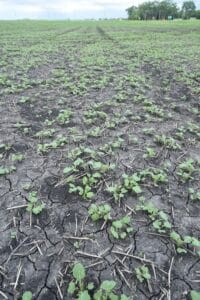
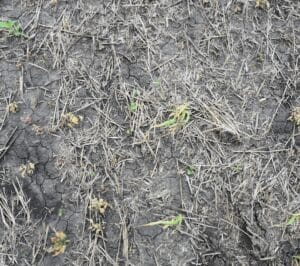
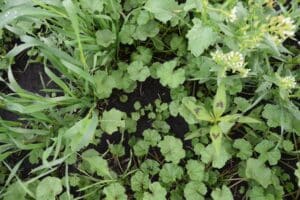
Equipment
Spreaders, floaters, Valmar-based applicators and airplanes can broadcast canola seed. Some applicators have multiple compartments, each with their own meters, to apply fertilizer and seed at the same time. Floaters can cover a lot of ground quickly. Some aerial applicators have seed spreaders for their planes, and new spreaders have metering wheels to set accurate rates even with various seed sizes. Another option is a regular air drill with openers lifted out of the ground. This avoids the drag and “mudding in” from having the openers engaged with the soil. If fields are iffy for firmness, farms could run with seed only and go back later to apply fertilizer.
Talk to the operator. Operators may have little to no experience seeding canola. Canola goes on at low rates, so can present a metering challenge. The grower may want to check the seed tank after the first few acres. If the operator is seeding a lot of acres, ask them to check for plugging in the air distribution system.
Fertilizer
A good-yielding crop needs fertilizer. Consider these fertilizer practices for broadcast canola:
- Apply the recommended rate of phosphorus. Canola plants need early access to phosphorus. When broadcast, phosphate prills and seed are not always close enough for timely access to the fertilizer. To help, use the full recommended rate, not the starter rate, when broadcasting.
- Use urease and nitrification inhibitors for nitrogen. Broadcast nitrogen has a higher risk of loss, especially on very moist soils. Combination products with urease and nitrification inhibitors are a good choice to protect the nitrogen in this situation. Consider a slightly lower-than-recommended nitrogen rate for canola broadcast in late May or early June. The full rate of nitrogen could extend the required days to maturity. More on urease and nitrification inhibitors.
- Seed soon after blending. Fertilizer could reduce canola seed viability if in a blend for more than a day or two. Ammonium sulphate was particularly damaging when left for any longer. (See the graph below.) Prills are also abrasive and can remove some of the canola seed treatment. Again, this is especially true for ammonium sulphate. Ammonium sulphate blended with canola seed will often take on a blue tint – suggesting a high rate of abrasion. Ammonium sulphate also has an affinity for moisture and can increase plugging in humid conditions. Fertilizer has the advantage of adding bulk to canola seed, which could make metering more accurate.
- Consider a split fertilizer application. Growers could seed first, then top up with appropriate forms of nitrogen and sulphur if the crop gets established.
- Broadcast nitrogen and sulphur, then drill seed. If broadcasting to avoid the risk of getting stuck when pulling a fully-loaded cart, growers could broadcast nitrogen and sulphur, and use the drill just for seed and phosphorus. That way, they wouldn’t have to fill the drill tank right full. Use an inhibitor to reduce nitrogen losses.
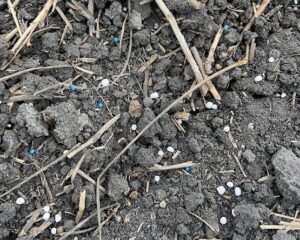
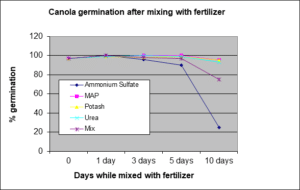
Residue
Successful broadcast seeding requires good seed to soil contact. This may not be possible in fields with lots of straw cover. With a thick layer of thatch, seed and fertilizer are not getting down to the soil surface. Spring cultivating ahead of broadcasting could create an equally inhospitable seedbed, with large clods and a crusted soil surface. Do not broadcast seed onto fields with thick residue. Seed can germinate in moist residue, but seedlings are not anchored. They can dry up and blow away in the wind.
Harrow after seeding
Harrowing or shallow cultivation will usually improve seed to soil contact. Aim to avoid creating lumps or clods during cultivation or straw piles with harrows. The ideal harrowing pass will run on a right angle to the floater pass. For this reason, harrow after the floater leaves the field – rather than “chase” the floater through the field.
Careful with weed control
Seeds on the soil surface are highly vulnerable to herbicide. Do not apply post-seed/pre-emergence glyphosate on Liberty Link and Clearfield canola seeds on the soil surface. TruFlex cultivars can tolerate glyphosate at this early stage. Weed control strategies for each HT system.
Crop insurance
Consult with provincial crop insurance for rules and eligibility related to broadcast seeding. Here are the basic rules, as of May 2022. Please check to make sure these rules still apply.
- AFSC in Alberta: If a field fails to establish or meet the minimum number of plants, which is two per square foot for hybrid-type canola – and this is not due to an insurable reason such as seeding method – AFSC will not cover that field.
- SCIC in Saskatchewan: SCIC expects producers who may be considering alternative seeding methods like broadcast and harrow to follow recommended seeding practices. If the crop fails to establish, compensation will not be available. Crops which successfully establish are eligible for ongoing yield-loss coverage. For more information by area, or how recommended seeding deadlines may impact coverage, contact the local SCIC office.
- MASC in Manitoba: Broadcast and aerial seeded crops are eligible for insurance under the following rules: (1) Growers must incorporate seed into the soil by mechanical means on or before the associated seeding deadlines for that crop. MASC will consider the date of incorporation to be the date of seeding. (2) Crops seeded by broadcast or aerial methods must fully establish in order to be eligible for AgriInsurance.
Yield expectations
Canola Watch reported on yield results from broadcast seeding in 2010 and 2011. We wrote: “Experience from the past two years of wet conditions in the eastern Prairies has shown that, in general, growers who tried broadcast or aerial methods to get fields seeded had issues all season long with thin stands, uneven maturity, weed control, low fertility and poor yields. Best results from broadcast seeding came from fields that were fertilized early and harrowed to improve seed to soil contact.” We then added that if field conditions allow for follow up passes to harrow and apply fertilizer, it means the fields could also soon be ready to seed with the drill.
A Westco Fertilizers study (Karamanos et al, 2001) compared broadcast and row-seeded canola at six sites in Alberta from 1997 to 1999. It concluded that row-seeding canola resulted in a significant yield advantage of 0.18 to 0.58 tonnes per hectare in four of the six experiments and no significant difference at the other two. (The yield advantage for row-seeded canola at the four sites was approximately 3 to 10 bu./ac., based on canola yielding around 50 bu./ac.). Another from 1977 (Clarke et al) compared broadcast and “drilled” canola head to head. Drilled canola had a yield advantage, but broadcast results were still pretty good.
Farms still a couple of weeks away from seeding with a drill may want to inquire about a floater as backup just in case further weather delays make drill seeding impractical.
